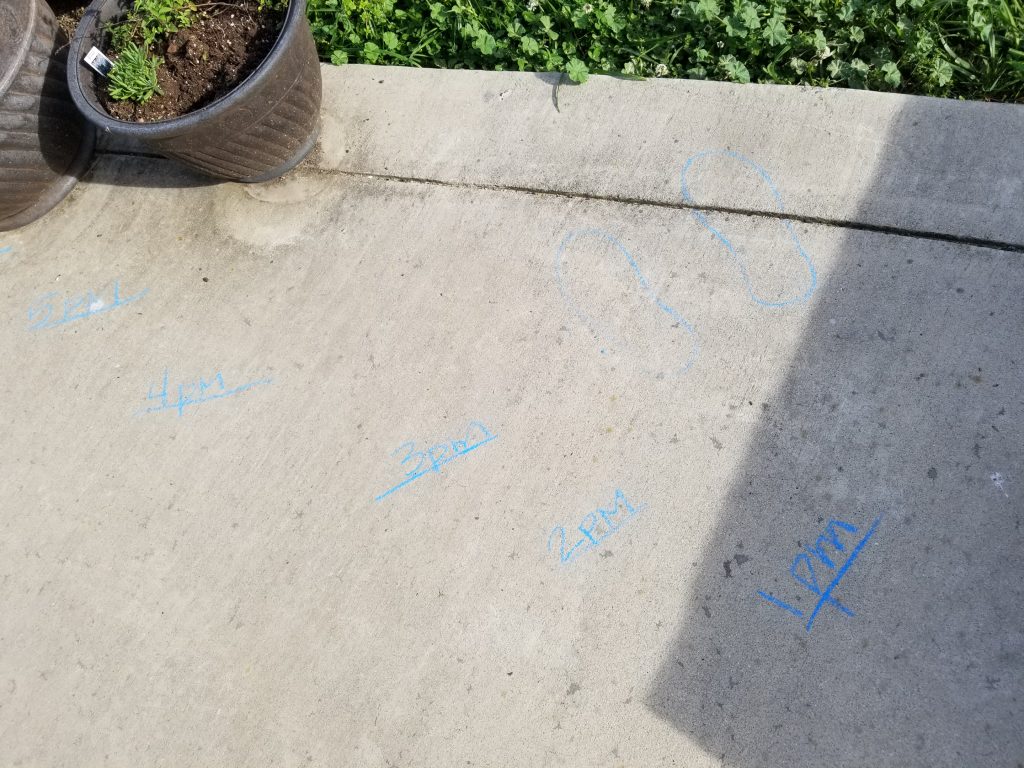Here Comes the Sun!
As part of the summer season, the sun is on the agenda. What can we do with sunshine, how can we protect ourselves from the sun, and what fun can we create? Today, in honor of National Sunscreen Day, we have created activities that all have a Sunny theme. These activities include things that will help your child develop fine and gross motor skills, problem-solving and engineering skills, and can help them engage in cooperative play, while fostering creativity and perseverance.

Each theme also comes with recommended literature and movie connections. Feel free to throw in your own activities that might relate, and don’t forget to post your results to social media and tag @discoverymuse to share with everyone else!
Art Activity/Fine Motor Activity – Sun Art with Cutouts
For this activity, you’ll need to grab two pieces of construction paper (1 should be dark), tape and a few rocks.
Directions
- Cut out some images from one piece of construction paper and lay them out on a second piece. Use tape to secure them.
- Place paper in a sunny area. Anchor the paper with some rocks or other materials to keep it from blowing away.
- Check back on the paper periodically, lifting away the top layer to view underneath. What is happening?
- When you feel like the paper has been outside in the sun long enough, bring the page out of the sun and remove the top layers. What happened to your paper?
- The sun’s rays will fade the paper. The second layer of paper will protect the layer below, so it will remain unfaded. This is how clothes and sunscreen work when we get a tan. The tanned skin is the exposed skin, while the skin covered by clothing/sunscreen remains untanned.
- To change this experiment up, try using different types of paper, different colors, different lengths of time, or different types of weather (cloudy vs sunny).
Science Experiment – Sunscreen Protection
- Collect some colored construction paper and a bottle of sunscreen.
- With a finger, a paintbrush or q-tip, spread some sunscreen on the paper. Make a design, draw your name, or just smear it about. Leave some of the paper unmarked.
- Place the paper into direct sunlight. Anchor the paper with rocks or other material to keep it from blowing away.
- Check back on paper periodically. What is happening?
- When you feel like the paper has been outside in the sun long enough, bring the page out of the sun and remove the top layers. What happened to your paper?
- The sun’s rays will fade the paper. The layer of sunscreen will protect the paper below, so it will remain unfaded. This is how sunscreen protects the skin from the sun’s rays. Skin with sunscreen will be protected, while skin without will change color!
Science Experiment – Solar Oven
- Collect a flat box, black paper/material, aluminum foil, plastic wrap, 1 marshmallow, chocolate pieces, and 2 graham crackers.
- Line your box with aluminum foil. Place the black paper in the center
- Place your graham crackers side by side. Put a marshmallow on one cracker and the chocolate pieces on the other.
- Cover top of box with plastic wrap.
- Place the box in a sunny space. Depending on the strength of the sun and the temperature of the day, your s’more can be ready in no time (more like 30-45 mins!).
Physical Activity – Human Sundial
Get some of those wiggles out while learning a little about sundials, the movement of the sun, and the path it takes over time. You will need a clock/watch, chalk, sidewalk, and sun.

- Find a sunny spot located on a section of the sidewalk that will receive sun for several hours.
- Have someone stand on the sidewalk and see if you can see their shadow.
- Have another person trace the shadow of their body, as well as around their shoes where they are standing.
- Identify the time of the shadow tracing (you can label the line).
- Repeat this several times throughout the day, indicating what time each measurement was taken.
- What do you notice as time goes by? What is happening to the line? Why do you think this is happening?
- Though it looks as if the sun is moving in the sky, the earth is the one moving, spinning on its axis, making one full turn every day. This is what causes day and night. It is easiest to track this turning by using or creating a sundial. The line moves progressively as the earth is making its rotation. Before clocks and watches were invented, people would tell time using sundials!
Conversation Starters and Research Questions
- Do you wear sunscreen when you go outside? Sunscreen comes in a variety of SPF levels. Which one does your family wear most often? Do you use spray-on, cream, or stick?
- Maybe you don’t wear sunscreen to protect you when you’re outside. What do you wear instead?
- Have you ever gotten a bad sunburn? What happened to cause it? How did you feel? What did you do to make it feel better? What could have been done to prevent it?
- Talk to your family about sundials. Has anyone in your family ever seen a sundial before? Where was it located? Was it accurate?
Videos and Websites
- Why Should You Wear Sunscreen SciKids video
- Why You Need Sunscreen video
- Kids Do Science – Sunscreen video
- How to be Safe When You’re in the Sun website
- The Sun Facts for Kids website
- All About the Sun for Kids video
Movie/Literature Connection:

Because we know you’re stuck at home with limited access to movies and books, we tried to compile a list that connects to today’s theme that you might already have in your collection or be able to access online. These include:
Books:
- The Day I Met My Shadow by Melissa Brun
- Hello, Sun A Yoga Sun Salutation to Start Your Day by Sarah Jane Hinder
- Fun in the Sun by David Catrow
- Fun Dog, Sun Dog by Deborah Heiligman
- Sammy Learns About Sunscreen by Manisha Shelley Kaura
- Sunshine on My Shoulders by John Denver, illustrated by Christopher Canyon
Music – A Sunny Day Playlistt!
- Here Comes the Sun by the Beatles
- Good Day Sunshine by the Beatles
- Walking on Sunshine by Katrina and the Waves
- Sunshine Song by Jason Mraz
- Sunshine on My Shoulder by John Denver
- Soak Up the Sun by Sheryl Crow
- Brighter than the Sun by Colbie Caillat
- You Are the Sunshine of My Love by Stevie Wonder
- Steal My Sunshine by Len
- Aquarius/Let the Sunshine by The 5th Dimension
- Ain’t Goin’ Down (Til the Sun Comes Up)
- Don’t Let the Sun Go Down on Me by Elton John
- California Sun by The Rivieras
- Pocketful of Sunshine by Natasha Bedingfield


